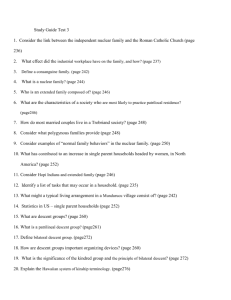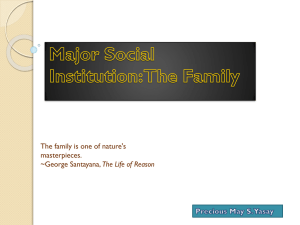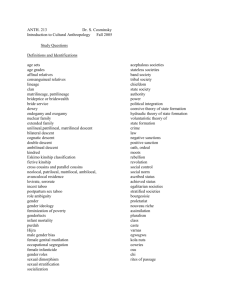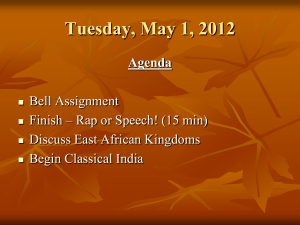Question: How is kinship defined culturally
advertisement
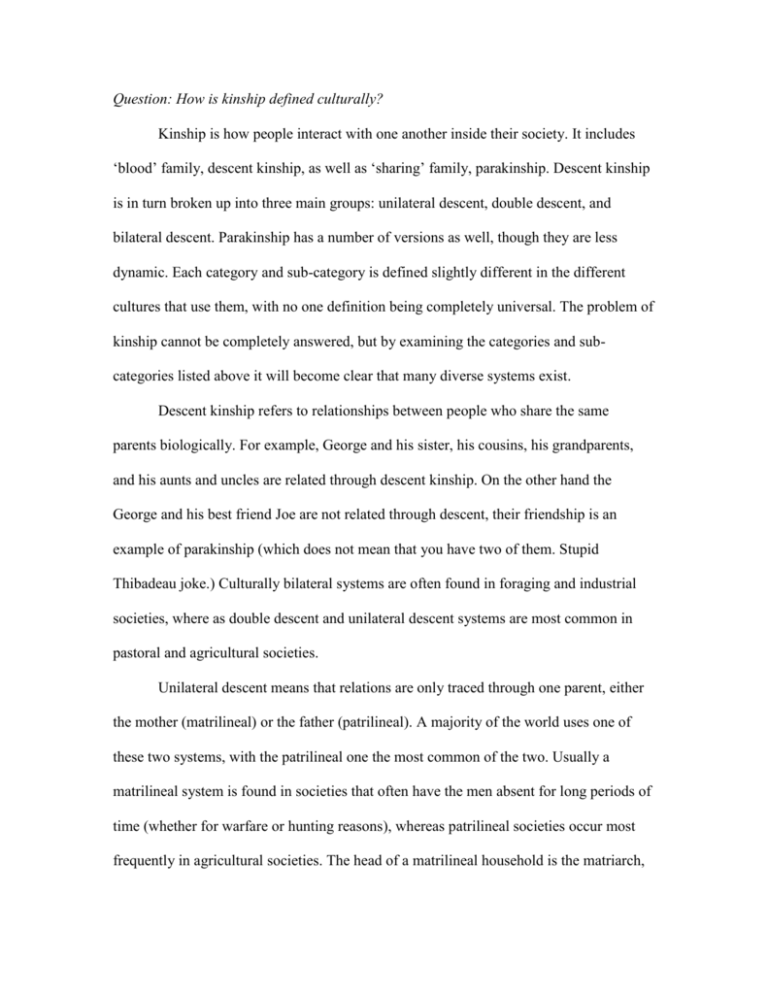
Question: How is kinship defined culturally? Kinship is how people interact with one another inside their society. It includes ‘blood’ family, descent kinship, as well as ‘sharing’ family, parakinship. Descent kinship is in turn broken up into three main groups: unilateral descent, double descent, and bilateral descent. Parakinship has a number of versions as well, though they are less dynamic. Each category and sub-category is defined slightly different in the different cultures that use them, with no one definition being completely universal. The problem of kinship cannot be completely answered, but by examining the categories and subcategories listed above it will become clear that many diverse systems exist. Descent kinship refers to relationships between people who share the same parents biologically. For example, George and his sister, his cousins, his grandparents, and his aunts and uncles are related through descent kinship. On the other hand the George and his best friend Joe are not related through descent, their friendship is an example of parakinship (which does not mean that you have two of them. Stupid Thibadeau joke.) Culturally bilateral systems are often found in foraging and industrial societies, where as double descent and unilateral descent systems are most common in pastoral and agricultural societies. Unilateral descent means that relations are only traced through one parent, either the mother (matrilineal) or the father (patrilineal). A majority of the world uses one of these two systems, with the patrilineal one the most common of the two. Usually a matrilineal system is found in societies that often have the men absent for long periods of time (whether for warfare or hunting reasons), whereas patrilineal societies occur most frequently in agricultural societies. The head of a matrilineal household is the matriarch, and the head of the patrilineal household is the patriarch. The Iroquois of upstate New York are one example of a matrilineal society, and the pre-kingship Israelites are an example of a patrilineal society. Because of the Euro-centrism associated with the colonial and neo-colonial periods, matrilineal societies are found less frequently then patrilineal ones, which were favoured by the male-dominated settlers. The second form of descent kinship is the double descent. This refers to a society where one traces their line through both the mother and the father. At first, anthropologists believed that these societies were patrilineal because immovable resources, such as land, went was passed down from father to son. Later though it became clear that more mobile forms of inheritance, such as livestock, and, in some cultures, magical charms and incantations passed from mother to daughter. These systems often arose where there was equilibrium between the male and the female parent inside the household. One example of this is the Baganté of West Africa. Modern western society, some believe, falls into a third patter of descent kinship. Bilateral descent does not favour the male or the female line over the other, and often the child is allowed to decide which parent to trace its descent through. In this system inheritance usually passes to each child equally, and the family unite lives apart from both parents in a neo-locality, which means that it is apt to change with economic and social factors. Canadian society, though, still holds some practices from our original patrilineal system. For example the custom is for the bride to adopt her husband’s last name, which the children then keep. In Latin-American cultures children take both their mother’s and their father’s last name, truer to the bilateral descent system then the Canadian practice. Parakinship is slightly different than this. These relationships are those between friends. Often they are informal, though at times intimate initiation rituals are followed, such as when joining a secret society. Another example are “blood-brothers” who in some way share each other’s blood, such as by piercing their hands and shaking them, allowing their blood to mingle. Any sharing relationship is ultimately a parakinship. In ancient Greece the bonds of phillia (between comrades-in-arms or business partners) and xenia (between guest friends) were very important and honoured. In modern society people often spend a lot of time with people who they are not related to, such as in a university residence situation. In these cases parakinship takes the place of the descent kinship in offering support and guidance. Kinship is complicated, but can be relatively neatly placed into two major categories, descent kinship and parakinship. Descent kinship is then divided into the three sub-categories of unilateral descent, bilateral descent, and dual descent. Different societies adapt these archetypes to their own needs, with often the most and least technologically advanced societies having bilateral descent systems, and societies in the middle tend towards either unilateral or dual descent. Parakinship is always important and links different family units together through other means, such as trade. Kinship, in short, is the relationship that exists between two people.

